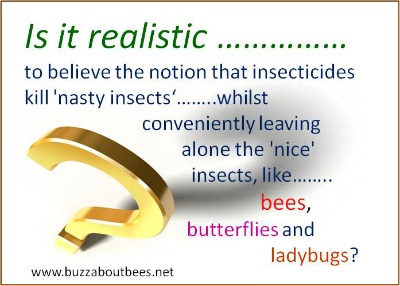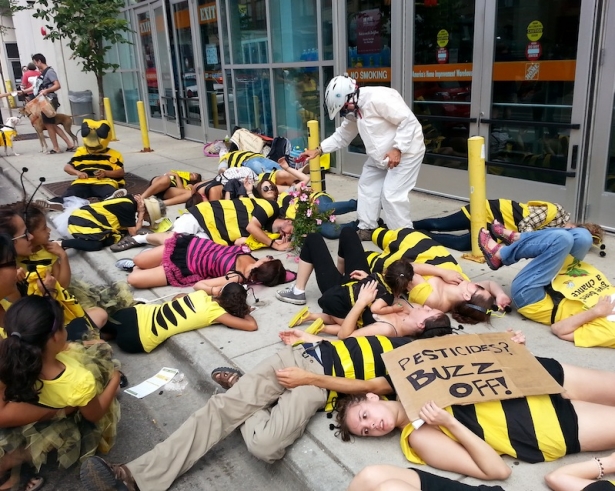Use of Neonicotinoids and the Impact on Bees
By Madison Schrock & Matt Mengel
What is all the buzz about saving the Bees?
There has been a recent decline
in the bee population that has been reported by many beekeepers and scientists.
The reduced number of bees in bee colonies has been labeled as Colony collapse
disorder (CCD) and an estimated as much as a 30% decline in bumble bees. Colony collapse disorder has many in the
United States and Europe concerned about the number of bees that appear to be
dying off. Multiple causes are now being considered, but one that is gathering
a lot of attention is the use of neonicotinoids. Neonicotinoids are a group of synthetic
chemical insecticides similar in structure to nicotine. The neonicotinoids have been used to control
pests that damage crops in agriculture, residential gardens and landscapes. The concern is that while they are not the
target for the pesticide, it is also affecting bees and other pollinators. The loss of bees and their impact on the
environment could have major implications for our food supply and biodiversity.
There has been a call to action
to raise awareness of the dangers of neonicotinoids that has allegedly been
killing and having other effects on bees.
This topic is getting a lot of social media attention and several groups
have adopted and slightly adjusted John Lennon’s lyrics:
“All
we are saying is give Bees a chance”
https://www.youtube.com/watch?v=0KeQYQHC7VY
"Neonics: Driving Declines in Biodiversity" is a video on youtube where British bumblebee ecologist Dr. David Goulson speaks about the impact of neonicotinoid pesticides on biodiversity declines in farmlands.
In this 54 second video on youtube, "Neonicotinoids banned in EU: How they harm bees", was produced by NMA news direct gives us a nice over view of the problem.
https://www.youtube.com/watch?v=xOsCOcvWIOk
Where is this Happening?..... All over the world


Where is this Happening?..... All over the world
(Map of the world, indicating the areas of decline in the honeybee)
Why are Bees so Important?
Bees
are a species of insects that span the globe in all terrestrial environments. Insects perform a number of valuable
ecosystem functions, an important one being pollination. Bees are largest in numbers in temperate
climates of the world. In these areas bees have the most economic importance of
any of the pollinators. They support the
reproduction of 85% of the world’s flowering plants and 35% of the world’s crop
production. Bees pollinate 71 out of 100
crops that provide 90% of the world’s food.
Honey bees are involved in over $15 billion in crop production a year. The bees are also important in the
terrestrial ecosystems because they pollinate the seeds and fruits that feed
other animals that range from birds to bears. Bees play such a huge role in
pollination that many people do not realize how important they are.
The Deadly combination of Neonicotinoids and Bees
Neonicotinoids
are currently the most widely used pesticide in the world. Their use in the
United States and Europe has sparked the interest of researchers and several research
projects have been preformed to determine their impact on pollinators. Worldwide sales of neonicotinoids were astoundingly
high in 2006, hitting around near 1.6 billion dollars. On todays market, there
are over 400 products that contain neonicotinoids. Neonicotinoids are one of the most widely
used insecticides in California and are being applied to thousands and
thousands of acres of farming and crops. They residue from this pesticide resides in the pollen and nectar consumed by bees, and is lethal in many situations. The bees can experience flying and navigation problems, as well as the reduction of their taste sensitivity (Are Neonicotinoids Killing Bees?). There is considerable evidence that indicates that bee populations are
declining and are in trouble due to the use of neonicotinoids. Complicating the issue is the vast amount of
money being made by the manufacturer of the Neonicotinoids. If a ban were to be
approved, they would stand to lose billions of dollars for their cooperation’s.
(These maps indicate the increasing use of neonicotinoids from 1994 to 2009 on farms in the United States. The darker the red represents where there is a greater amount used per square mile.)
Specifics of the Problem
No Bees= No Pollination= No Food
Understanding Neonicotinoids
The
world today there is more people on earth then ever before, and this growing
human population needs to be fed. The chemical insecticides that are vital to
food that is produced on farms are put in action to protect and preserve about
one-fifth of the crop yield. There is some disagreement about whether or not
the chemicals are really necessary at the levels they are being used. There are
six types of neonicotinoid insecticides that are used on crops. They can be
applied by spraying them directly onto the crops used as seed coatings or
chemigation (addition of the insecticide to water).
Seed Coatings
Seed
coatings are systemic, in that they can be absorbed and transported throughout
the plant. This absorption of the seed
coating allows them to be very resistant to insects that feed on the plants.
The plant absorbs the chemicals in the seed coating through their roots and
leaves and then can be transported to stems, flowers and even fruit. It is also present in the nectar and
pollen. If the nectar and pollen are contaminated
with these systemic insecticides, then bees are consuming them during their pollination.
Honeybees are often exposed to pesticides because they rely heavily on crops
that are routinely treated with neonicotinoids to work against insect pests.
(This picture describes the process of how the systematic pesticides are coated on the seed and spread through all parts of the plant when it blossoms. So when the Bee takes in the pollen, it also takes in the pesticide that proceeds to attack the central nervous system leading to paralysis of the bee and even death)
(This chart describes the correlation between the population of bees and honey production. Ass the bee population goes down, so does the honey population. This chart illustrates the decline in honey production from 1986-2012. It highlights the drops in honey production with the introduction of neonicotinoids for use in 1994 and then in 2000 when they were approved for use for corn.)
Larger Consequences of the Problem

How Big is this Problem?
The neonicotinoids are systemic:
water soluble and pervasive. They are therefore
remaining toxic in the plants for a longer period of time, then say what a
sprayed insecticide would last. Consumers are buying and using neonicotinoids
that are not controlled or regulated.
Often times these levels are even higher than what is used in large
scale agricultural operations. The
plants they purchase at their local store can be pretreated with neonicotinoids
without them even knowing. It only
seems to reason that in addition to eliminating the pests that harm crops these
neonicotinoids are also harming and possibly killing helpful insects like bees
and other beneficial insects like beetles and wasps. These beneficial insects are involved in
important roles for healthy functioning ecosystems. Insects are the bottom of the food chain and
without them it impacts the food chain all the way up.
Research has shown that queen
bees died when exposed. Also sublethal effects are contributing to their
deaths. Research has also found that neonicotinoids may not only be lethal to
bees but can also have side-effects.
These side effects for bees can impact motor and sensory skills that
impair bees ability to fly and return back to their hives
Solutions
Bringing Awareness to the issue of Neonicotinoids and Bees
There
needs to be funding approved for research so there is more awareness and
information about this topic. The
solutions cannot be determined nor implemented without action and funding by
the governments in the countries that are using neonicotinoids. Bee keepers and environmental groups in the
United States filed a lawsuit against the Environmental Protection Agency (EPA)
for failing to protect bees from neonicotinoid pesticides. Activists in the United States are asking the
Environmental Protection Agency to take action to ban neonicotinoids because if
bee populations continue to decline the worlds food sources are at risk. Governments in Europe have pushed back and
have taken action to ban their use. The
European Food Safety Authority (EFSA) released a report that ruled
neonicotinoid insecticides are essentially “unacceptable” for many crops. The EFSA determined that there was a
considerable lack of information with huge gaps in data and research. Yet they did find that there are a number of
risks posed to bees by neonicotinoid insecticides. They further determined that when it comes to
the neonicotinoid in pollen and nectar in the flowers of treated plants, only
those plants that bees are not attracted to are acceptable.
President Weighs in on Solution
On June 20, 2014 the President of the United
States issued a memorandum creating a federal strategy to promote the health of
honey bees and other pollinators. The
memorandum did not specifically mention neonicotinoids but it did contain information
indicating that “scientist believe that bee losses are due to exposure to
pesticides” (Presidential
Memorandum- Creating a Federal Strategy to Promote the Health of Honey Bees and
Other Pollinators, Obama). The solutions outlined in the
memorandum include: studies, collection and sharing of data regarding pollinator
losses, monitoring bee hive health, developing seed mixes for pollinator
friendly plants, identifying new ways to limit pollinator exposure to
pesticides, and restoring pollinator habitats.
(Bee protestors at home depot in Chicago that were protesting the use of pesticides that were thought to be involved in large number of bee deaths.)
- Their goal was to raise the awareness of neonicotinoids and how dangerous they are to bees.
- On woman participating in the protest stated, "[if] we don't have bees, we don't have pollination. We don't have pollination, we don't have food" (All They are Saying, is Give Bees a Chance).
(Big agriculture chemical companies are fighting to prevent bans of neonicotinoids and in some cases have even asked for permission to use even larger quantities of these pesticides than in currently allowed.)
- This is a youtube video made by Alicia Previn called "Give Bees a Chance"
- This song was made in order to spread awareness of the issue of decline in bee population
- SAVE THE BEES!
Works Cited
Blacquiere, Tjeerd. "Neonicotinoids in Bees: A Review
on Concntrations, Side-effects and Risk Assessment." Ecotoxiology 21.4 (2012): 973-92. Web.
Hopwood, Jennifer, Mace Vaughan, Mathew Shepard, and David
Biddinger. "Are Neonicotinoids Killing Bees? A Review of Research into the
Effects of Neonicotinoid Insecicides O Bees, with Recommendations for
Action." The Xerces Sociey for
Invertebrat Consveration (n.d.): n. pag. Web.
Kogan, Alex. "All They Are Saying, Is Give Bees a
Chance - The ITT List." All They Are
Saying, Is Give Bees a Chance - The ITT List. N.p., 18 Aug. 2014. Web. 12
Mar. 2015.
"No Bees, No Food: Lets Give Bees a Chance." Eniroment America. N.p., n.d. Web. 8
Mar. 2015.
Whitehorn, Penelope R., and Stephanie O'Connor. "Go to
Science." Science Magazine: Sign In.
N.p., 29 Mar. 2012. Web. 12 Mar. 2015.







No comments:
Post a Comment